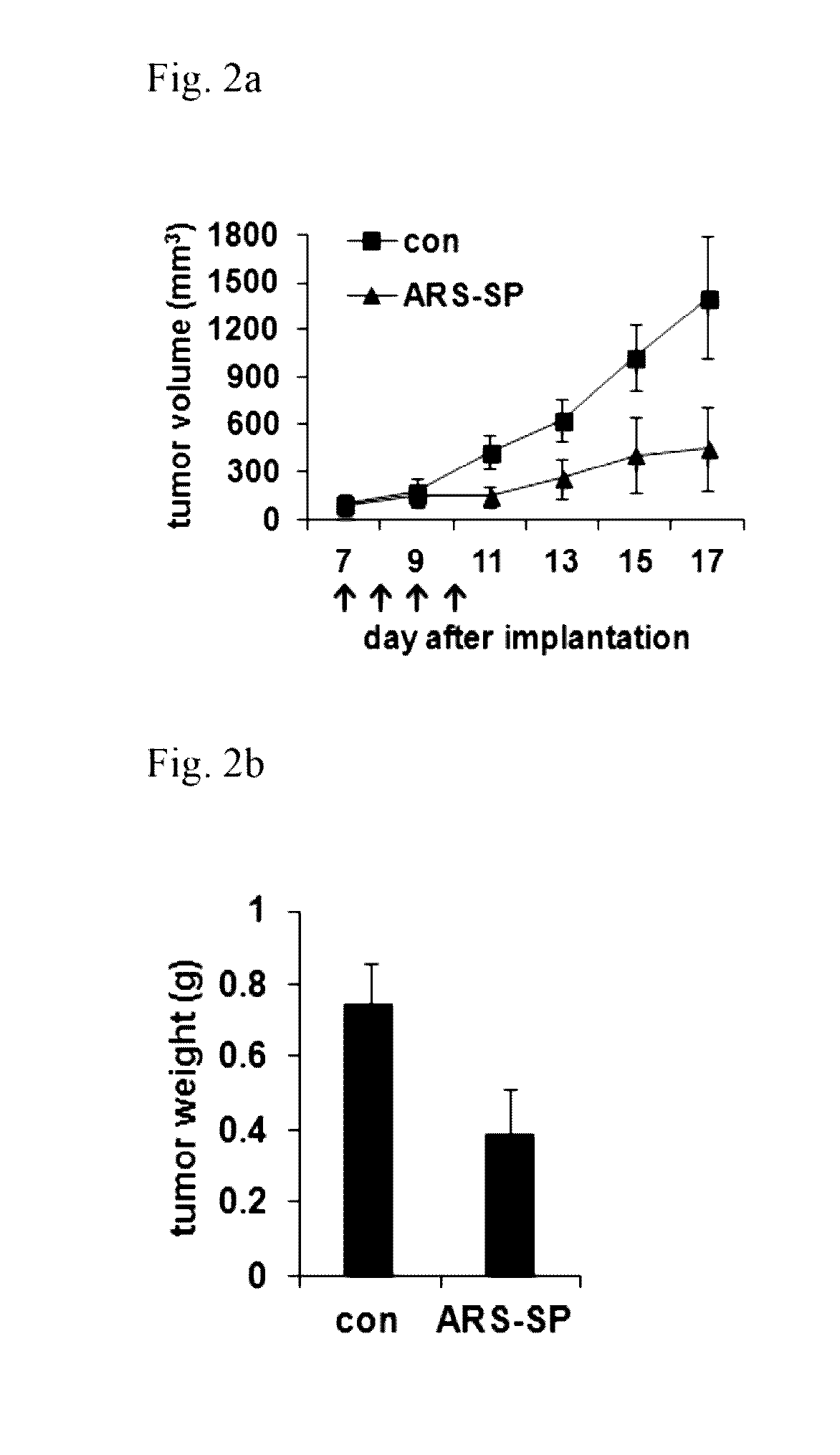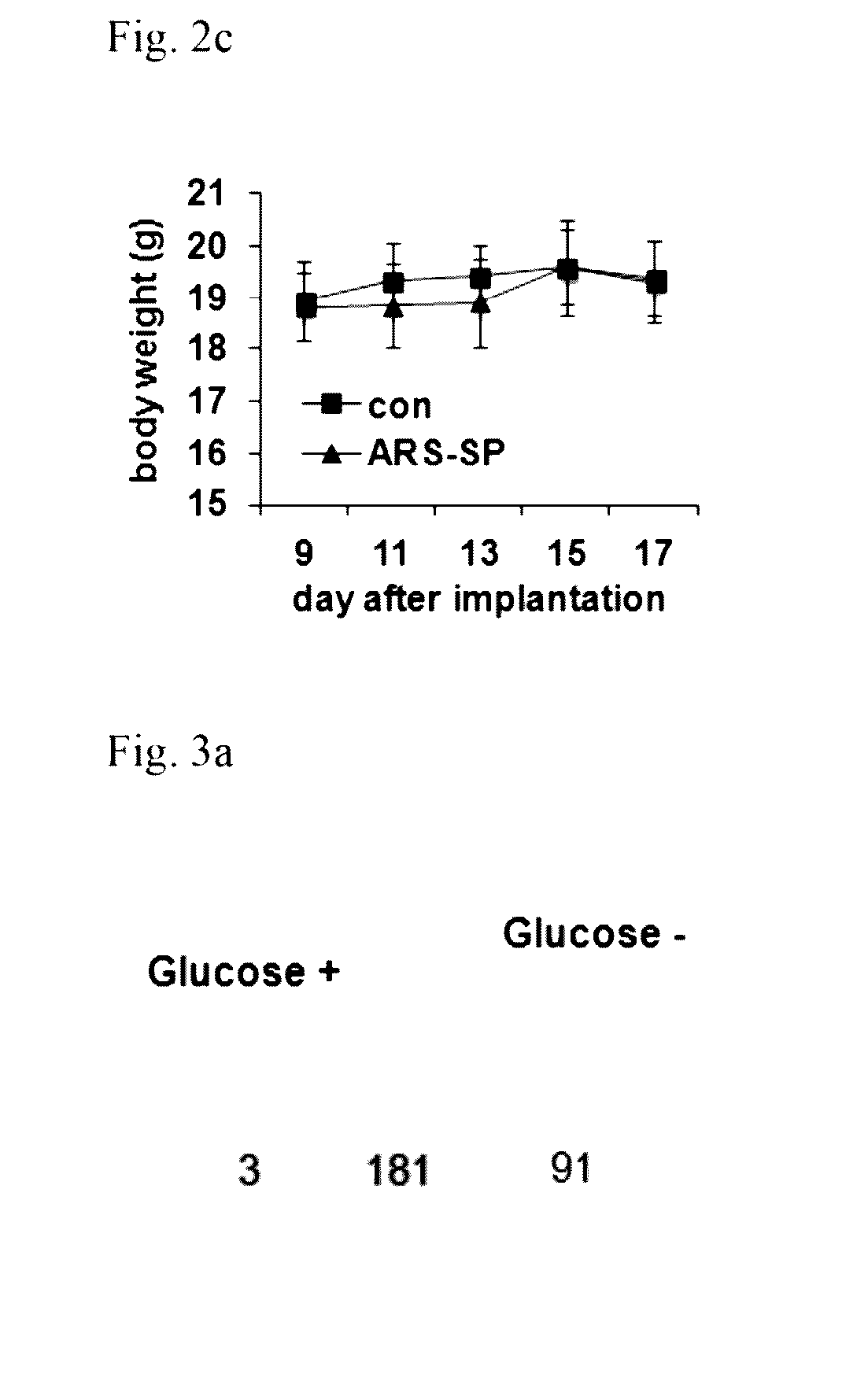Nanoparticles comprising aminoacyl trna synthetase and anticancer composition comprising same
a technology of aminoacyl trna and aminoacyl trna, which is applied in the direction of drug compositions, ligases, peptide/protein ingredients, etc., to achieve the effect of enhancing immune function and preventing or treating cancer
- Summary
- Abstract
- Description
- Claims
- Application Information
AI Technical Summary
Benefits of technology
Problems solved by technology
Method used
Image
Examples
example 1
In Vitro Anticancer Effect of Nanoparticles Secreted from Macrophages
[0171] Obtaining of Nanoparticles Secreted in Glucose-Deprived Condition
[0172]RAW 264.7 cells were cultured in glucose-deprived DMEM medium (4 hr). Subsequently, the medium was centrifuged twice at 500 g (10 min) and 10,000 g (15 min) to remove cell debris, and then centrifuged at 100,000 g (120 m) to give pellet lipid particles.
[0173] Verification on In Vitro Anticancer Effect
[0174]In order to investigate the anticancer effect of the nanoparticles obtained in Example 1-1, H460 and RAW 264.7 cells were treated with the obtained nanoparticles to determine their viability, respectively.
[0175]As a result, it was found that, on the contrary to that of RAW264.7 cells, the viability of H46C cells was decreased by the treatment of with the nanoparticles in a dose-dependent manner (FIG. 1a). In addition, 15 different cancer cell lines (HCT116, SN12C, Caki-1, H1975, HCC44, HCC15, A549, H23, HCC2108, H1703, MCF7, BT-474, REN...
example 2
In Vivo Anticancer Effect of Nanoparticles Secreted From Macrophages
[0176]In order to investigate whether the nanoparticles obtained in Example 1-1 also possess an in vivo anticancer effect, the nanoparticles were administered into xenograft mice. H460 cells were injected into BALB / c mice and then grown for 7 days. When tumors were grown to an average size of 90 mm3, the nanoparticles (6 mg / kg / dose) were injected by intravenous route once a day for 4 days. PBS was used as control. Compared with the control, the nanoparticle-treated tumor volume (FIG. 2a) and weight (FIG. 2b) were reduced by 68% and 48%, respectively. The lack of change in the weight and posture of the tested animals suggested no nanoparticle-induced overt toxicity (FIG. 2c). These results further support that the nanoparticles obtained in Example 1 possess an anticancer effect.
example 3
[0177]Proteomics Profiling of Nanoparticles Secreted From Macrophages
[0178]In order to test whether the total amount of the nanoparticles secreted in Example 1-1 was increased according to the introduction of glucose-deprived stress, RAW264.7 cells were stained with DiI (lipophilic fluorescence tracer). After the dye was washed off, the cells were cultured in both the glucose-containing condition and the glucose-deprive condition, respectively. After the particles secreted by the same method as in Example 1 were purified, the total fluorescence intensity was determined. It was verified that the total fluorescence intensity and the protein content of the secreted particles were enhanced by glucose starvation. These particles were confirmed to contain GRS. When the cells were stained with DiI and DAPI, no difference was observed among the cells cultured under the conditions of the presence or the absence of glucose. This suggests that the difference in the fluorescence intensity of th...
PUM
| Property | Measurement | Unit |
|---|---|---|
| diameter | aaaaa | aaaaa |
| diameter | aaaaa | aaaaa |
| particle size | aaaaa | aaaaa |
Abstract
Description
Claims
Application Information
 Login to View More
Login to View More - R&D
- Intellectual Property
- Life Sciences
- Materials
- Tech Scout
- Unparalleled Data Quality
- Higher Quality Content
- 60% Fewer Hallucinations
Browse by: Latest US Patents, China's latest patents, Technical Efficacy Thesaurus, Application Domain, Technology Topic, Popular Technical Reports.
© 2025 PatSnap. All rights reserved.Legal|Privacy policy|Modern Slavery Act Transparency Statement|Sitemap|About US| Contact US: help@patsnap.com



